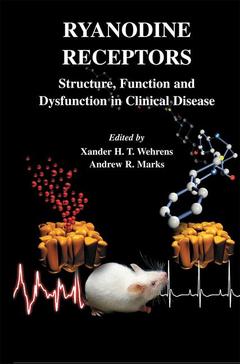Ryanodine Receptors, 2005 Structure, function and dysfunction in clinical disease Developments in Cardiovascular Medicine Series, Vol. 254
Coordonnateurs : Wehrens Xander H. T., Marks Andrew R.

In recent years, the ryanodine receptor has emerged as a new and very promising target for the treatment of several cardiovascular disorders, including cardiac arrhythmias and heart failure. This volume is the most current publication devoted to the major intracellular calcium-release channel, the ryanodine receptor.
"In this series of brief but informative chapters, the contributions progress from the basic gene family and primary structure, through its 3D structure so far, to its regulation and physiology."
David E. Clapham, MD, PhD
Professor of Neurobiology and Pediatrics
Harvard Medical School
Dr. Xander H.T. Wehrens received his M.D. and Ph.D. degrees from Maastricht University in the Netherlands. His research has mainly concentrated on molecular mechanisms of cardiac arrhythmias, in particular in the setting of inherited arrhythmogenic syndromes and congestive heart failure. This work has led to the development of novel anti-arrhythmic therapies. He is currently a research scientist in the Department of Physiology and Cellular Biophysics at the College of Physicians and Surgeons of Columbia University.
Dr. Andrew R. Marks is the Chair and Professor of the Department of Physiology and Cellular Biophysics at Columbia University College of Physicians and Surgeons. Dr. Marks' research has focused on understanding how macromolecular signaling complexes regulate ion channel function in muscle and non-muscle systems, and on the regulation of vascular smooth muscle proliferation and migration. His work has contributed new understandings of fundamental mechanisms that regulate muscle contraction that have lead to the discovery of molecular defects that contribute to heart failure and fatal cardiac arrhythmias.
Most current publication devoted solely to the major intracellular calcium-release channel, the ryanodine receptor
Will quickly bring anyone interested in ryanodine receptors up to speed with its brief but informative chapters
Drs. Xander Wehrens and Andrew Marks have gathered the collected wisdom of scientists that have devoted their working lives to the study of ryanodine receptors
Includes supplementary material: sn.pub/extras
Date de parution : 12-2014
Ouvrage de 330 p.
15.5x23.5 cm
Thème de Ryanodine Receptors :
Mots-clés :
cardiovascular; pathophysiology; physiology; skeletal muscle; smooth muscle



